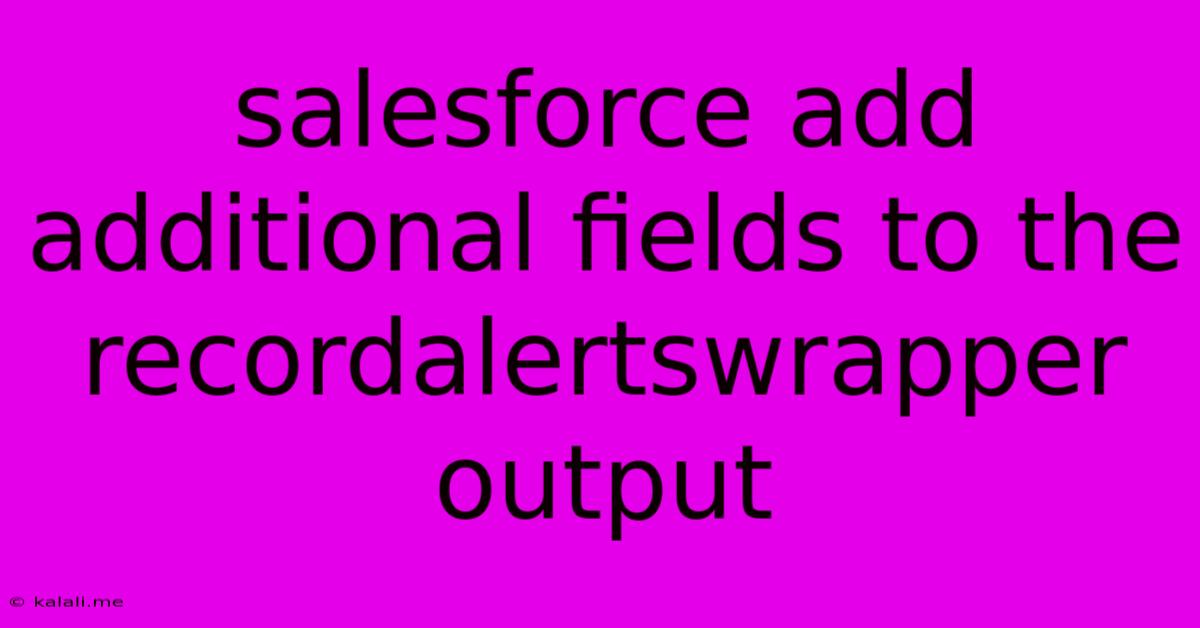Salesforce Add Additional Fields To The Recordalertswrapper Output
Kalali
Jun 09, 2025 · 3 min read

Table of Contents
Adding Custom Fields to Salesforce RecordAlertWrapper Output
Salesforce's RecordAlertWrapper is a powerful tool for displaying notifications and alerts related to record changes. However, the default output might not always contain all the information you need. This article will guide you through the process of extending the RecordAlertWrapper to include custom fields, enhancing the usefulness of your alerts. This will improve visibility of key data points and streamline your workflow. Learn how to customize your alert notifications for maximum efficiency.
This process involves leveraging Apex to modify the data included in the RecordAlertWrapper before it's displayed. We'll focus on adding custom fields to improve the context and information presented in these alerts. By the end, you'll be able to tailor your alerts to display precisely the information relevant to your business needs.
Understanding RecordAlertWrapper
Before diving into customization, let's briefly review the RecordAlertWrapper. It's a standard Salesforce class that bundles information about record changes, typically used to display alerts in the user interface. The default output generally includes standard fields like record ID, record name, and the type of change (create, update, delete). However, many situations demand more detailed information. For example, you might want to include the value of a specific custom field in the alert to provide immediate context.
Extending RecordAlertWrapper with Apex
The core of this customization lies in creating a custom Apex class that extends the functionality of the RecordAlertWrapper. This custom class will fetch the necessary custom fields and include them in the alert's output. This approach ensures a clean and maintainable solution.
Here's a sample Apex class that demonstrates this:
public class EnhancedRecordAlertWrapper extends RecordAlertWrapper {
public String customField1__c {get; set;}
public String customField2__c {get; set;}
public EnhancedRecordAlertWrapper(RecordAlertWrapper originalWrapper) {
super(originalWrapper.getRecord(), originalWrapper.getEventType(), originalWrapper.getChanges());
// Fetch custom field values here
try{
SObject record = originalWrapper.getRecord();
this.customField1__c = String.valueOf(record.get('Custom_Field_1__c'));
this.customField2__c = String.valueOf(record.get('Custom_Field_2__c'));
} catch (Exception e){
//Handle exceptions appropriately, e.g., log the error
System.debug('Error fetching custom fields: ' + e);
}
}
}
Replace Custom_Field_1__c and Custom_Field_2__c with the actual API names of your custom fields. This class takes the standard RecordAlertWrapper as input and adds properties for your custom fields. The try-catch block is crucial for handling potential errors during field retrieval.
Integrating the Custom Class
After creating your custom Apex class, you'll need to integrate it into your alert generation process. This typically involves modifying the code responsible for displaying alerts. The exact implementation depends on how your alerts are currently generated (e.g., using Visualforce, Lightning Web Components, or Apex triggers).
The key is to instantiate your EnhancedRecordAlertWrapper using the existing RecordAlertWrapper and use the enhanced wrapper to display the alert, allowing your custom fields to be included.
Considerations and Best Practices
- Error Handling: Robust error handling is paramount. Anticipate potential issues like null values or exceptions during field retrieval.
- Data Types: Handle various data types appropriately. Consider using appropriate methods to convert field values to strings for consistent display.
- Performance: Avoid unnecessary database queries within the custom class. Optimize field retrieval to minimize performance impact.
- Security: Ensure your code adheres to Salesforce security best practices. Only access fields with appropriate permissions.
By implementing these steps, you can successfully extend the functionality of the RecordAlertWrapper to include crucial custom fields, thereby enhancing the clarity and usefulness of your Salesforce record change alerts. Remember to always test thoroughly to ensure your custom alerts function correctly. This detailed approach will help you get the most out of your Salesforce alerts and contribute to a more efficient workflow.
Latest Posts
Latest Posts
-
Piecewise Defined Function Real Life Example
Jun 09, 2025
-
Integral Of 1 X 1 2
Jun 09, 2025
-
Can Viruses Be Downloaded With Mp4
Jun 09, 2025
-
Can You Make Rice Ahead Of Time
Jun 09, 2025
-
What Do You Call A Large Break Room
Jun 09, 2025
Related Post
Thank you for visiting our website which covers about Salesforce Add Additional Fields To The Recordalertswrapper Output . We hope the information provided has been useful to you. Feel free to contact us if you have any questions or need further assistance. See you next time and don't miss to bookmark.